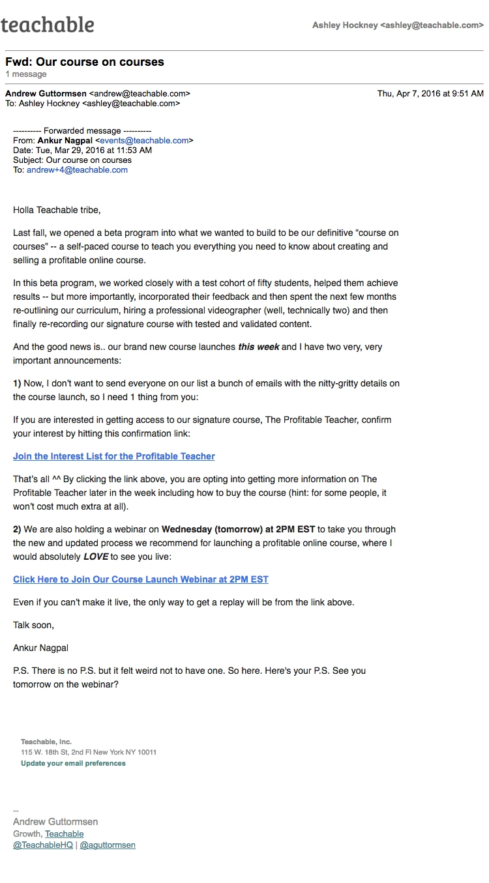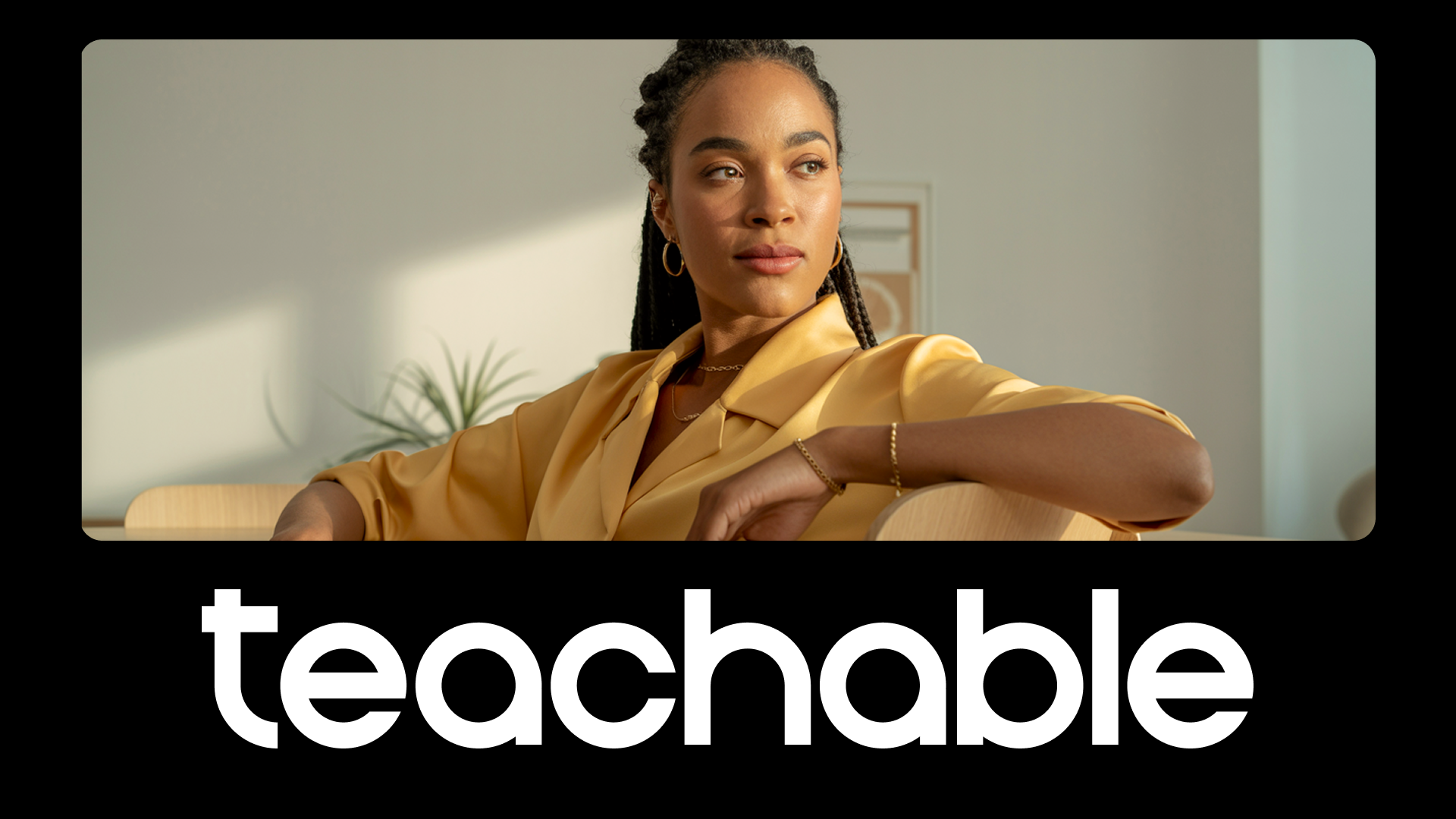Starting any business requires a lot of moving parts to fall into place. Creating and launching an online course is no different. But similarly, having a well-thought out launch strategy can make taking a product to market much easier.
In the world of online courses and coaching, one of the most important steps to launching revolves around a solid launch email and strategy. Below, find everything needed to learn for launching an online course or product—think strategy, timing, and even advice for email copy.
Build it before you sell it
Prior to launching an online course, you should make sure you’re armed with two things: an email list and 20 percent of the content ready to go.
The email list: the backbone of good business
Consider the email list a collection of the core crew—those who already are interested in the topic at hand. Pre-launch, this is critical to contact and draw support for any course topic prior to even making one say. With the right email sequence, creators can build trust, anticipation, and urgency to increase sales.
What’s more, according to Campaign Monitor, emails convert at three times the rate of social media. For this reason, the most effective place to spend time is on a strong email list. A strong rule of thumb is to expect about 2% of email list subscribers to become customers. So to set a basic revenue goal, take two percent of total subscribers and multiply by the price of the course. Need tips for growing an email list, visit here.
Strong sales page: Show them a little of what you’ve got
It’s no grand secret that consumers like to know what they’re purchasing before handing over money. But, don’t be fooled into thinking that means every single aspect of an online course or coaching service needs to be created and fully laid out from the start. Oftentimes, a strong sales page and compelling message is enough to land a sale.
Creator Bree Noble said she sold her course based off of her sales page alone.
“I was able to pre-sell my online course (Female Musician Academy) to 15 people at $290 ($4,350) without having any content in the school yet. In fact, my new students told me that my Teachable school was so beautiful that they could tell the course was going to be amazing.”
Drip lists the additional benefits of making sales before producing the entire product as generating revenue to finance the project, gathering testimonials to help with conversion rates, and further giving motivation to finish. Ultimately, creating 20% of content, means there’s still time to adjust the remaining 80% to create a more meaningful—and valuable—course for students.
Teachable’s own drip feature allows you to automate when each course section is sent out via email. Even if you batch up your work and create three sections during one productive weekend, you can still have the courses sent out week after week at their discretion.
Launch strategy: a doubled approach
Think of a launch strategy as two sides of a coin: the education side and the selling side. Neither can function without the other, and every creator needs to pay attention to both when launching an online course.
Education phase: school them, then sell them
In the education phase, you’re essentially warming up your list. You’re getting familiar with the audience and getting them familiarized with the product and the pain points it solves.
Here, the goal is to generate demand for what you’re teaching by educating, creating an understanding of the product, increasing a need for the benefit, and building trust through high-quality content.
This education phase can last 0-14 days depending on how long each creator wants to grow their lists before launching. Every two to three days, aim to send one of the following:
- Targeted blog posts
- Webinars
- Videos
- Offer group coaching
- Any type of content that shows students what’s offer
A good schedule for warming up a list is, if educating over:
- 0-7 days: send four emails
- 7-9 days: send five emails
- 10-14 days: send six emails
The fear with emails is often over communication, but if the work was done right and has secured qualified leads via the email list, those subscribers want content.
Selling phase: let the games commence
Once the email flow is set, the selling phase can begin with—you guessed it—emails. This time, it’s all about marketing the course. From building excitement to actually giving subscribers the opportunity to buy, the following outline serves as a play-by-play email guide creators can follow.
Day 1: The course teaser email
Here is where you should first announce your course to subscribers, explain what it’s about, and most importantly, that it will be enrolling soon so subscribers should pay attention to their email.
Upbeat, positive phrases like: “I’ll share the fun details later”, “The excitement is building”, and “I’ve been working so hard on this for you.”
Below is an example from Teachable’s launch of The Profitable Teacher.

Day 2: The “What’s in the course” email
There’s no secret as to what goes in this email. Although you should write this from a “sales angle,” it’s important to remember this simply means adding empathy and explaining the final benefits of the course, and not just the features.
For example:
- Bad: “We provide email segmentation.”
- Good: “We provide email segmentation that lets you target interested parties and make an average of 30 percent more on each sale.”
Building up the takeaways of the course and the value of the “bonus content” offered only increases excitement and creates an urge to purchase. You can even consider adding in a click-to-tweet option to allow subscribers to share out their course.
Either way, make sure the email announces when the course will be available to purchase and enroll.

Day 3: The course launch email
This email should have one primary message—the course is open for purchasing. Include a link to the sales page and highlight any testimonials, stats from articles, bonus content, or anything else relevant to the launch that further validates the course.

Day 4: The FAQ email
Although it may not sound like the most exciting of emails in your flow for launching an online course, the FAQ email is one of the most valuable for creators. It can answer all of the logistical questions and get down to the nitty gritty. Consider addressing the following questions in an FAQ email:
- How long do students have to buy?
- How long will students have access to the course?
- Is there a money back guarantee?
- Are there payment plans?
- Are you dripping content or will it become available all at once?
- Who is this course right for?
- How much time does it take to complete?

Day 5: The surprise bonus email
This email can serve as the extra shot of espresso in your morning latte—it’s much welcomed. Use this email to offer an incentive to those who buy now. This can be some kind of valuable bonus content—like a workbook, a coaching session, a free tool, or a limited-time discount. Whatever it is, make sure it’s valuable and worth the immediate purchase action.
Day 6: The thank you and social proof email
This is a great time to show gratitude to those who have already purchased and offer up social proof of the course’s value to those who haven’t purchased yet. This can include heart-felt thank yous as well as testimonials. As long as it’s sincere, this is a powerful email.
Day 7: The logic and closing email
All good things must come to an end, so as the course launch period draws to an end, now is the time for creators to build a logical argument for why customers should buy now. This can include a reference to the bonus content or a discount—anything to increase urgency to purchase.

{{profitable-component="/blog-shortcodes/blog-popup"}}
Day 8: The last chance email
Give those lagging customers one last chance to purchase prior to the course launch period ending. This email has the potential to result in the most profitable day. Finish the marathon strong and consider the following three emails to close the deal:
- 9AM send: Emphasize the course enrollment ending and the time at which it’s done.
- 3-4PM send: Utilize this email to express gratitude and drive it home that the course window is closing.
- Email three sent an hour before the cart closes: Give customers one last shot—just in case.
Portions of this article were repurposed from a previous post from Ashley Hockney.
Join more than 150,000 creators who use Teachable to make a real impact and earn a real income.



.png)
.png)



